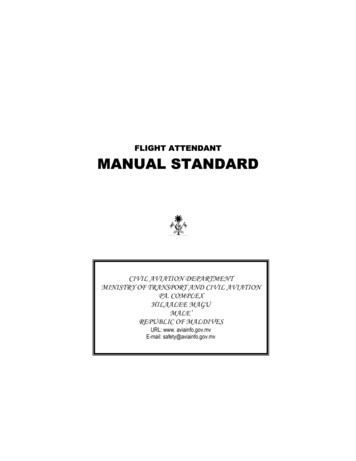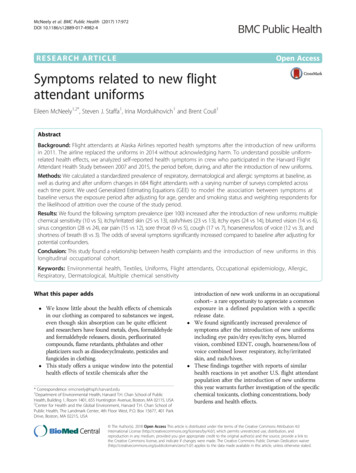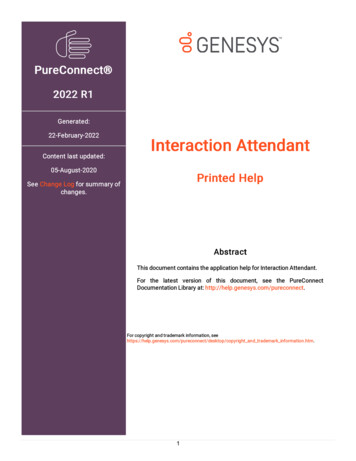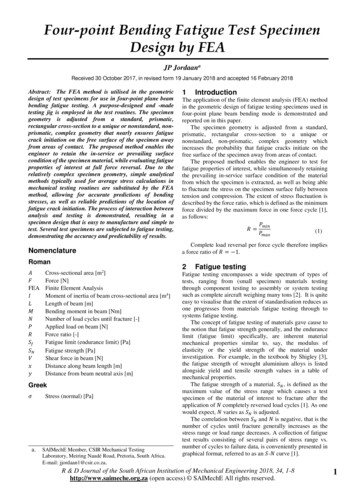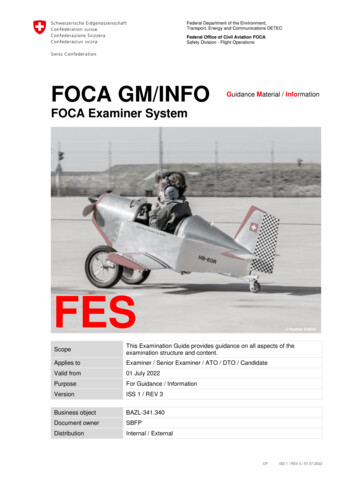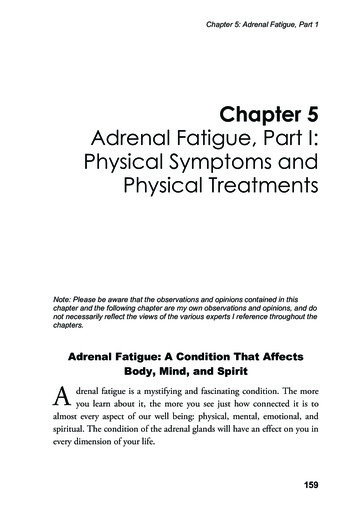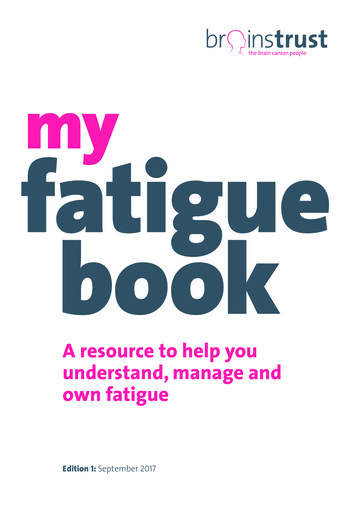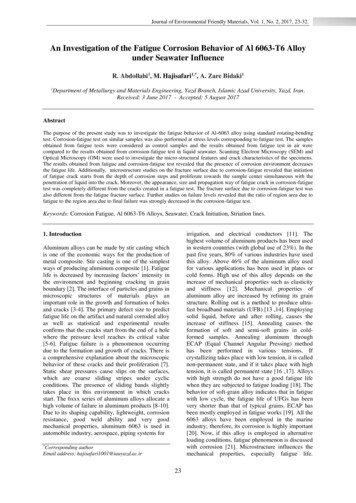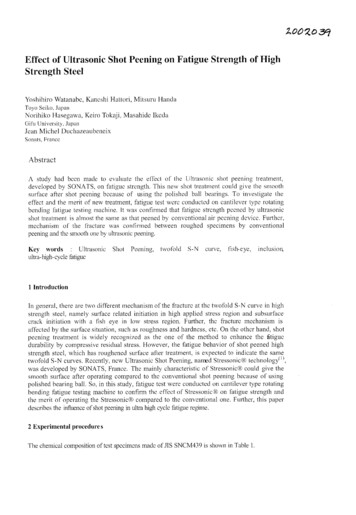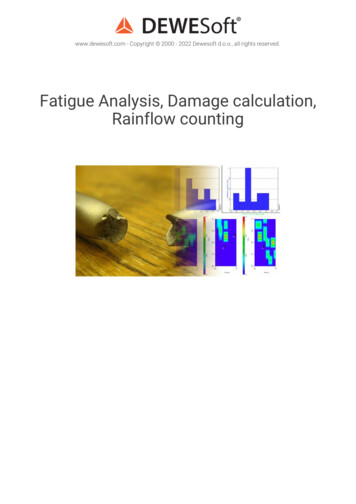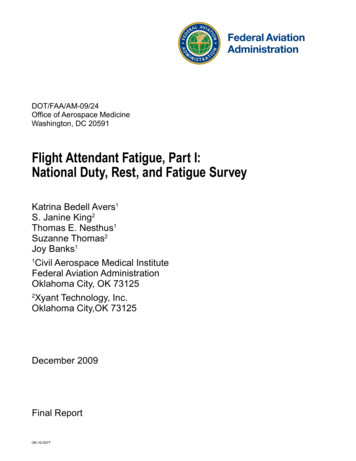
Transcription
DOT/FAA/AM-09/24Office of Aerospace MedicineWashington, DC 20591Flight Attendant Fatigue, Part I:National Duty, Rest, and Fatigue SurveyKatrina Bedell Avers1S. Janine King2Thomas E. Nesthus1Suzanne Thomas2Joy Banks11Civil Aerospace Medical InstituteFederal Aviation AdministrationOklahoma City, OK 731252Xyant Technology, Inc.Oklahoma City,OK 73125December 2009Final ReportOK-10-0077
NOTICEThis document is disseminated under the sponsorshipof the U.S. Department of Transportation in the interestof information exchange. The United States Governmentassumes no liability for the contents thereof.This publication and all Office of Aerospace Medicinetechnical reports are available in full-text from the CivilAerospace Medical Institute’s publications Web ports
Technical Report Documentation Page1. Report No.2. Government Accession No.DOT/FAA/AM-09/243. Recipient's Catalog No.4. Title and SubtitleFlight Attendant Fatigue, Part I: National Duty, Rest, and Fatigue Survey5. Report DateDecember 20096. Performing Organization Code7. Author(s)8. Performing Organization Report No.12121Avers KB, King SJ, Nesthus TE, Thomas S, Banks J9. Performing Organization Name and Address110. Work Unit No. (TRAIS)FAA Civil Aerospace Medical InstituteP.O. Box 25082Oklahoma City, OK 731252Xyant Technology, Inc.Oklahoma City, OK 7312512. Sponsoring Agency name and Address11. Contract or Grant No.13. Type of Report and Period CoveredOffice of Aerospace MedicineFederal Aviation Administration800 Independence Ave., S.W.Washington, DC 2059114. Sponsoring Agency Code15. Supplemental NotesWork was accomplished under approved task AM-A-08-HRR-52116. AbstractToday’s aviation industry is a 24/7 operation that produces a variety of challenges for cabin crew membersincluding extended duty periods, highly variable schedules, frequent time zone changes, and increased passengerloads. While these operational requirements may be necessary, they are far from ideal with respect to the humanbody’s biological rhythms for managing sleep and alertness. In fact, acute sleep loss, sustained periods ofwakefulness, and circadian factors resulting from this form of misalignment all contribute to fatigue and fatiguerelated mishaps (Caldwell, 2005; Rosekind et al., 1996). This survey study was conducted to identify the specificoperational factors that may contribute to fatigue in cabin crew operations. A retrospective survey wasdisseminated to flight attendants representing 30 operators (regional 17, low-cost 7, and network 6). Thesurvey addressed 7 main topics: work background, workload and duty time, sleep, health, fatigue, workenvironment, and general demographics. Participants were 9,180 cabin crewmembers who voluntarily andanonymously completed the survey and met the criteria to be included in the report (i.e., active flight attendantthat had flown the previous bid period with their current airline). This report outlines the results of this surveyand provides specific recommendations regarding fatigue issues in cabin crew operations.17. Key WordsFatigue, Flight Attendant, Survey, Duty Time, Workload,Scheduling19. Security Classif. (of this report)Unclassified20. Security Classif. (of this page)UnclassifiedForm DOT F 1700.7 (8-72)18. Distribution StatementDocument is available to the public through theDefense Technical Information Center, Ft. Belvoir, VA22060; and the National Technical InformationService, Springfield, VA 2216121. No. of Pages2322. PriceReproduction of completed page authorizedi
ContentsBackground . . . . . . . . . . . . . . . . . . . . . . . . . . . . . . . . . . . . . . . . . . . . . . . . . . . . . . . . . . . . . . . . . 1Introduction. . . . . . . . . . . . . . . . . . . . . . . . . . . . . . . . . . . . . . . . . . . . . . . . . . . . . . . . . . . . . . . . 1Fatigue Definition. . . . . . . . . . . . . . . . . . . . . . . . . . . . . . . . . . . . . . . . . . . . . . . . . . . . . . . . . . . . . . 1Nature of Fatigue. . . . . . . . . . . . . . . . . . . . . . . . . . . . . . . . . . . . . . . . . . . . . . . . . . . . . . . . . . . . . . . 2Flight Attendant Workload . . . . . . . . . . . . . . . . . . . . . . . . . . . . . . . . . . . . . . . . . . . . . . . . . . . . . . . 2Flight Attendant Duty Time Regulations . . . . . . . . . . . . . . . . . . . . . . . . . . . . . . . . . . . . . . . . . . . . 3Other Aviation Factors Contributing to Fatigue. . . . . . . . . . . . . . . . . . . . . . . . . . . . . . . . . . . . . . . . 3Scope of the Report. . . . . . . . . . . . . . . . . . . . . . . . . . . . . . . . . . . . . . . . . . . . . . . . . . . . . . . . . . . . . 4Method . . . . . . . . . . . . . . . . . . . . . . . . . . . . . . . . . . . . . . . . . . . . . . . . . . . . . . . . . . . . . . . . . . . . . . 4Survey. . . . . . . . . . . . . . . . . . . . . . . . . . . . . . . . . . . . . . . . . . . . . . . . . . . . . . . . . . . . . . . . . . . . . . . 4Participants . . . . . . . . . . . . . . . . . . . . . . . . . . . . . . . . . . . . . . . . . . . . . . . . . . . . . . . . . . . . . . . . . . . 4Administration. . . . . . . . . . . . . . . . . . . . . . . . . . . . . . . . . . . . . . . . . . . . . . . . . . . . . . . . . . . . . . . . . 4Data and Analysis . . . . . . . . . . . . . . . . . . . . . . . . . . . . . . . . . . . . . . . . . . . . . . . . . . . . . . . . . . . . . . 5Results . . . . . . . . . . . . . . . . . . . . . . . . . . . . . . . . . . . . . . . . . . . . . . . . . . . . . . . . . . . . . . . . . . . . . . . 5Demographics. . . . . . . . . . . . . . . . . . . . . . . . . . . . . . . . . . . . . . . . . . . . . . . . . . . . . . . . . . . . . . . . . 5Health. . . . . . . . . . . . . . . . . . . . . . . . . . . . . . . . . . . . . . . . . . . . . . . . . . . . . . . . . . . . . . . . . . . . . . . 5Work Background. . . . . . . . . . . . . . . . . . . . . . . . . . . . . . . . . . . . . . . . . . . . . . . . . . . . . . . . . . . . . . 5Workload and Duty Time . . . . . . . . . . . . . . . . . . . . . . . . . . . . . . . . . . . . . . . . . . . . . . . . . . . . . . . . 6Sleep . . . . . . . . . . . . . . . . . . . . . . . . . . . . . . . . . . . . . . . . . . . . . . . . . . . . . . . . . . . . . . . . . . . . . . . . 7Fatigue. . . . . . . . . . . . . . . . . . . . . . . . . . . . . . . . . . . . . . . . . . . . . . . . . . . . . . . . . . . . . . . . . . . . . . . 9Work Environment. . . . . . . . . . . . . . . . . . . . . . . . . . . . . . . . . . . . . . . . . . . . . . . . . . . . . . . . . . . . 13Discussion. . . . . . . . . . . . . . . . . . . . . . . . . . . . . . . . . . . . . . . . . . . . . . . . . . . . . . . . . . . . . . . . . . . 13Limitations . . . . . . . . . . . . . . . . . . . . . . . . . . . . . . . . . . . . . . . . . . . . . . . . . . . . . . . . . . . . . . . . . . 13Fatigue in Cabin Crew Operations. . . . . . . . . . . . . . . . . . . . . . . . . . . . . . . . . . . . . . . . . . . . . . . . . 13Fatigue Factors Identified. . . . . . . . . . . . . . . . . . . . . . . . . . . . . . . . . . . . . . . . . . . . . . . . . . . . . . . . 14Scheduling Factors. . . . . . . . . . . . . . . . . . . . . . . . . . . . . . . . . . . . . . . . . . . . . . . . . . . . . . . . . . . . . 14Other Fatigue Considerations . . . . . . . . . . . . . . . . . . . . . . . . . . . . . . . . . . . . . . . . . . . . . . . . . . . . 15Shared Responsibility. . . . . . . . . . . . . . . . . . . . . . . . . . . . . . . . . . . . . . . . . . . . . . . . . . . . . . . . . . . 15Fatigue Countermeasure Education. . . . . . . . . . . . . . . . . . . . . . . . . . . . . . . . . . . . . . . . . . . . . . . . 15Recommendations. . . . . . . . . . . . . . . . . . . . . . . . . . . . . . . . . . . . . . . . . . . . . . . . . . . . . . . . . . . . . 15References . . . . . . . . . . . . . . . . . . . . . . . . . . . . . . . . . . . . . . . . . . . . . . . . . . . . . . . . . . . . . . . . . . 16iii
AcknowledgmentThank you to the many airlines, labor organizations, and flight attendants for your collaboration,support, and feedback.v
Executive SummaryToday’s aviation industry is a 24/7 operation thatproduces a variety of challenges for cabin crew members including extended duty periods, highly variableschedules, frequent time zone changes, and increasedpassenger loads. While these operational requirementsmay be necessary, they are far from ideal with respectto the human body’s biological rhythms for managingsleep and alertness. In fact, acute sleep loss, sustainedperiods of wakefulness, and circadian factors resultingfrom this form of misalignment all contribute to fatigueand fatigue-related mishaps (Caldwell, 2005; Rosekindet al., 1996). This survey study was conducted to identifythe specific operational factors that may contribute tofatigue in cabin crew operations.A retrospective survey was disseminated to flightattendants representing 30 operators (regional 17,low-cost 7, and network 6). The survey addressed 7main topics: work background, workload and duty time,sleep, health, fatigue, work environment, and general demographics. Participants were 9,180 cabin crewmemberswho voluntarily and anonymously completed the surveyand met the criteria to be included in the report (i.e.,active flight attendant that had flown the previous bidperiod with their current airline).The majority (84%) of cabin crewmembers indicatedthey had experienced fatigue while on duty in the previousbid period. When asked to indicate their level of agreement with a series of statements regarding fatigue, 93%agreed that they had experienced fatigue at work. Themajority (93%) indicated that flight attendant fatiguerepresents a safety risk, and 91% agreed that fatigue was acommon occurrence. Despite the frequency of occurrenceand safety implications, only 35% of flight attendantsreceived any type of training or information regardingfatigue from their airline. Of those who had receivedtraining, 79% reported that the training was helpful toa “limited extent” or “not at all.”Fatigue factors identified by respondents includedlength of duty days, consecutive duty days, rest periods,nutrition, and others. The most frequently identifiedfatigue factors regarded length of duty day, consecutiveduty days, missed meals, and lack of breaks. Schedulingfactors made up 9 of the 10 most common operationalchange recommendations that flight attendants proposedto reduce flight attendant fatigue. The most commonrecommendations included: eliminate reduced rest, do notmix continuous duty overnight with early-morning reporttimes, maintain consistent scheduling, limit number offlight segments/legs, limit number of duty hours allowed,start scheduled rest period on arrival at hotel, lengthen restperiods, do not schedule several-hour breaks or “airportsits” between flight segments/legs, schedule enough timebetween flight segments/legs for meals, and provide flightattendants with food and beverage on flights.The data from cabin crewmembers also recommended improved fatigue management education andexamination of scheduling practices. Education plays acritical role in any effort to address fatigue in aviationoperations and can provide benefits to both the individual and the organization (Avers, Hauck, Blackwell,& Nesthus, 2009). Analyzing scheduling practices,identifying potential improvements, and implementingchanges may result in reduced fatigue, as well as otherbenefits to operations.vii
Flight Attendant Fatigue, Part I:National Duty, Rest, and Fatigue SurveyBackgroundIntroductionWhile substantial research has been conducted onhuman circadian processes as applied to scheduling andtraining of flight crews, relatively little research has beenaccomplished among cabin crews. Performance of cabinduties is critical to safety and security, and the literaturesuggests that all human performance is vulnerable tosleep loss and daily variations in physiological processestied to underlying body-clock mechanisms. The extent ofsleep loss and fatigue and its impact upon performanceof duties among the cabin crew population and withinthe current duty regulations is unknown.In 2005, a Congressional directive to the Civil Aerospace Medical Institute (CAMI) was given to addressissues regarding flight attendant fatigue. CAMI contractedwith the National Aeronautics and Space AdministrationAmes Research Center’s Fatigue Countermeasures Groupto conduct literature and incident report reviews andexamine a range of typical flight attendant schedules toassess potential vulnerability to fatigue. Nesthus, Schroeder, Connors, Rentmeister-Bryant, and DeRoshia (2007)concluded that some degree of fatigue-related performanceimpacts were likely under the current regulations andsuggested 6 areas of research that would facilitate understanding and government-industry decision making.The 6 recommendations included: 1) a survey of fieldoperations; 2) field research on the effects of fatigue; 3) avalidation of models for assessing flight attendant fatigue;4) a focused study of incident reports; 5) a review ofinternational policies and practices; and 6) the potentialbenefits of training.In 2008, Congress provided another directive forCAMI to conduct follow-on studies in each of the 6recommendation areas noted in the 2007 report. To accomplish this directive, CAMI researchers developed aproject plan for completing each recommendation. Tofacilitate support for these projects and ensure participation, CAMI researchers coordinated with representativesof vested organizations (e.g., Air Transport Association,Regional Airline Association, Coalition of Flight Attendants, and non-unionized carriers) and provided themwith the opportunity to review and comment on aspectsof the project plan prior to commencement.The current report provides specific details regardingthe national survey of flight attendant field operations(recommendation #1). This report will be incorporatedinto CAMI’s consolidated report to Congress.In a recent Aviation Safety Reporting System (ASRS)report, a flight attendant reported “ We were supposedto get meals. No meals. During the flight, all 4 of uswere dizzy and very fatigued. I sat down on my jumpseat and started to fall asleep. My eyes were burning andI was extremely hungry. If an emergency had happened,I would not have been able to perform. I feel this wasextremely unsafe due to the fact that all 4 of us could notrest before the flight” (ASRS report 785013). Fatiguerelated incident reports, like this one, began to increasefollowing the events of 9/11 and have continued to increasewith the onset of an economic recession and subsequentreductions in the flight attendant workforce (Holcomb etal., 2009). Following the events of 9/11, Brown (2009)surveyed 291 flight attendants and pilots and asked themif fatigue had ever affected their ability to perform theirduties safely; 97% said that fatigue may “somewhat”affect their ability to perform duties safely; and 68%responded that fatigue would “greatly” affect their abilityto complete their duties safely. The preliminary evidencesuggests that flight attendants are experiencing fatigue,and their safety performance is at risk.Fatigue DefinitionFatigue is a multi-dimensional construct that has beendefined and interpreted in a number of ways (Åkerstedtet al., 2004; Dodge, 1982). Most commonly, fatigue isdescribed as sleepiness or a general tired feeling resultingfrom extended wakefulness, insufficient sleep, or circadiandisruption (Åkerstedt, 1995a; Dinges, 1995). Althoughthis definition sufficiently describes fatigue in a generalway, it inadequately represents the performance decrements associated with fatigue. In the aviation industry,it may be better to consider fatigue in terms of its symptoms such as forgetfulness; poor decision-making; slowedreaction time; reduced vigilance; poor communication;impaired mood; nodding off; or becoming fixated, apathetic, or lethargic (Rosekind et al., 1996). It is important to recognize that fatigue is more than sleepiness ortiredness. Fatigue has psychological, physiological, andemotional implications that can impact the performanceof safety-related duties, particularly during non-routineand emergency events.1
Nature of FatigueExtended duty times, rotating shifts, night flights, andtransmeridian travel can all contribute to fatigue and thesubsequent performance, alertness, and well-being ofpersonnel via 2 biologically-based mechanisms: 1) thebody’s circadian rhythm or internal body clock, and 2) thehomeostatic mechanism or recent sleep history (includingthe amount of time since the last sleep period and theamount of prior sleep) (Caldwell, 2005).Circadian Rhythm. The circadian rhythm is the body’s24-hr internal clock that regulates bodily functions suchas body temperature, hormone secretion, digestion,performance capabilities, and mood (Rosekind et al.,1996). Most notably, the circadian rhythm controls sleepand wakefulness patterns based on naturally occurringlight-dark cycles in the environment (Dinges, Graeber,Rosekind, Samel, & Wegmann, 1996). Humans are preprogrammed to respond to these cues. In other words,the body is programmed to be awake when it is lightand asleep when it is dark (Caldwell, 2005). There are2 periods of circadian low or physiological sleepiness: inthe early-morning hours from 0200 – 0700 and, to alesser degree, during mid-afternoon from 1400 – 1700(Akerstedt, 1995b; Caldwell, 1997; Mitler et al., 1988;Rosekind et al., 1996). These rhythms coincide withshift worker performance models and indicate that shiftworkers have an increased number of errors and delayedreaction times during periods of circadian low (Shappell, Patterson, & Sawyer, 2007). The circadian rhythmcannot adjust immediately to changes in the work/restschedule or time zone. When such changes occur, thecircadian rhythm is desynchronized from the environmentfor a period of time, and individual rhythms are out ofsync with one another. The evidence suggests that workschedules in conflict with the circadian rhythm can resultin cognitive and psychomotor performance decrements(Caldwell, 2005).Homeostatic Sleep Mechanism. The homeostatic sleepprocess represents the accumulated sleep debt that occurswith increasing time awake, which dissipates with sleep(Billiard & Kent, 2003). The homeostatic mechanisminteracts with the circadian rhythm and can result inprogressive deterioration in alertness and performanceas homeostatic pressure increases. Homeostatic regulation involves 2 factors that influence one’s most recentsleep history: 1) quality and quantity of sleep prior to aperformance period and 2) the amount of continuouswakefulness prior to a performance period (Caldwell,2005). Sufficient daily sleep is a critical component inthe homeostatic regulation of alertness and is often oneof the first casualties in aviation operations. The evidencesuggests that aircrews suffer from work-related sleepdisturbances in a manner comparable to industrial shiftworkers that complain about sleep patterns and lack ofsleep (Costa, 1997). Sleep loss is measured by time awake(not time on duty) and is central to the homeostaticallybased drowsiness and inattention that is known to beproblematic in work that involves non-standard schedules(Rosekind et al., 1996). In fact, 2 hours of sleep loss canresult in performance and alertness decrements and anincreased likelihood of error or accident (Carskadon& Roth, 1991; Mitler et al., 1988). A significant sleepdebt can accumulate with 5 hours of sleep per night for7 consecutive nights and can result in increased stress,subjective fatigue, fatigue, mood disturbance, tension, anddecreased psychomotor vigilance performance (Dinges etal., 1997). Alternatively, continuous wakefulness beyond17 hr can result in performance decrements comparable to an individual considered legally drunk (BAC 0.05–0.10) (Arnedt, Wilde, Munt, & MacLean, 2001;Lamond & Dawson, 1999; Maruff, Falleti, Collie, Darby,& McStephen, 2005).Flight Attendant WorkloadCabin crew fatigue is thought of primarily as a functionof scheduling and workload (Nesthus et al., 2007; Samel,Wegmann, & Vejvoda, 1995). Technological advances inthe last 20 years have enabled passenger planes to increasein size and capacity, fly longer distances, and fly longernon-stop flights. With these advances, duty times andflight attendant responsibilities have also increased. Onaverage, a flight attendant arrives one to 2 hours beforea flight to begin pre-flight duties, continues to work during flight, and finishes the flight with post-flight duties(Nesthus et al., 2007). At completion of the post-flightduties, a flight attendant will either prepare for the nextflight or conclude the duty day and travel to rest accommodations. Examples of flight attendant activitiesperformed while on-duty include:Pre-flight duties: Check E-mail, attend a pre-flightbriefing, stock the galley, check all emergency and otherequipment, monitor passenger access and seating, assistwith the stowage of luggage, arm doors, and fill out andprovide the flight crew with relevant paperwork.Routine flight duties: Attend to passenger safety andcomfort. Flight attendants provide safety instructions;enforce safety rules; prepare and serve food and drinks;distribute pillows, blankets, and magazines; work audioand video equipment; collect trays, glasses, and newspapers; answer passenger questions; and communicate asneeded with the flight crew.Non-routine flight duties: Depending on the emergency,flight attendants must notify the flight crew of malfunctioning equipment or emergency situations, deal with illor disruptive passengers, operate first-aid or other medicalequipment, distribute medication, operate emergency2
equipment, instruct passengers on emergency landings,direct the evacuation of passengers, and various otherduties as needed.Post-flight duties: Disarm doors, deplane passengers,check and tidy the cabin, report cabin discrepancies tothe flight crew members, and report to operations fore-mail and other instructions.As evidenced above, flight attendants engage in anumber of physically demanding tasks and are always“on” as they interact continuously with passengers. Themost challenging tasks, however, seem to be those relatedto ensuring safety and responding to non-routine situations. Unfortunately, previous research on flight attendantfatigue indicates that safety-related duties may be mostsusceptible to the effects of fatigue and circadian rhythmdysfunction (Nesthus et al., 2007).may not be scheduled for duty if they have not had atleast the minimum rest requirements. Furthermore, flightattendants must be relieved from duty for at least 24 hrduring any 7 consecutive calendar days.A 14-hr duty period may be extended up to 20 hr ifthe carrier schedules additional flight attendants above theminimum complement required. One additional flightattendant is required above the minimum complement toextend the scheduled duty hours to 16 hr. If 2 additionalflight attendants are scheduled, the duty hours may beextended to 18 hr; and if 3 additional flight attendantsare scheduled, the duty hours may be extended to nomore than 20 hr. Table 1 summarizes the CFR as theyrelate to flight attendant schedules (Nesthus et al., 2007).The CFRs, however, are limited in scope and do nottake into account a number of operational issues thataffect fatigue, such as time-zone transitions, layover andrecovery, duty day start or end times, and the individual’sactual sleep need. In fact, existing fatigue research indicatesthat circadian disruption or circadian desynchrony aremore important to fatigue concerns than simply “timeon task” (Nesthus et al., 2007).Several studies have examined the question of theamount of time a flight attendant has to be on dutybefore fatigue sets in. In one study (Simonson, 1984),the majority of flight attendants set the fatigue rangeat 6-10 hr of duty. However, 21% were not fatigueduntil completing 11-15 hr of duty. In another study(Galipault, 1980), the duty lengths that flight attendantsthought induced tiredness ranged from 4 hr (10%), 5–6hr (51.1%), to 7–9 hr (27.6%). This study also foundthat short-duration flights with beverage or snack serviceproduced large increases in end-of-duty fatigue.Flight Attendant Duty Time RegulationsThe Code of Federal Regulations (CFR) is the codification of the general and permanent rules published inthe Federal Register by the executive departments andagencies of the Federal Government, one of which is theFAA. Two sections of Title 14 of the CFR regulate flightattendant duty time and rest requirements (CFR, 2003a;CFR, 2003b).The current regulations (14 CFR §121.467 &§135.273) require that flight attendants receive aminimum rest period of 9 consecutive hours followinga scheduled duty period of 14 hr or less (CFR, 2003a;CFR, 2003b). This rest period may be reduced to 8 hr ifthe subsequent rest period is at least 10 consecutive hours.Following a scheduled duty period of greater than 14 hr,but no more than 20 hr, a minimum rest period of 12 hrmust be provided. This may be reduced to 10 hr if thesubsequent rest period is at least 14 consecutive hours.If the rest period is reduced to 10 hr, the flight attendantmay not be scheduled for a duty period of greater than14 hr during the 24-hr period commencing after thebeginning of the reduced rest period. Flight attendantsOther Aviation Factors Contributing to FatigueFlight attendants are exposed to many other factors believed to contribute to or compound the risk offatigue. Nesthus et al. (2007) conducted a literaturereview to identify the factors that influence fatigue inTable 1. Summarized Flight Attendant (FA) Rest Periods According to CFRs.Scheduled DutyPeriod(Hours)14 or less14-1616-1818-20*Normal MinimumRest Period(Hours)9121212Reduced RestPeriodSubsequent RestPeriodNumber of imum 1Minimum 2Minimum 3*Applies only to duty periods with one or more flights that land or take off outside the 48 contiguous states and theDistrict of Columbia.Note: Generally, rest periods begin no less than 15 min after the aircraft pulls into the gate and continues until 1 hrprior to a flight attendant’s next departure.3
cabin crew operations. They collected and examined 99articles, websites, and other sources. The factors identified were: time pressure, high task demands, prolongedmental or physical exertion, extreme temperatures, timezone changes, personal demographics, nutrition andhydration, physical or medical problems, commuting,additional jobs, sleep environment, flight duration andtype, and work environment. For a detailed discussion ofthese specific issues see: Enck, Muller-Sacks, Holtmann,and Wegmann, 1995; Ewing, 1999; Haugli, Skogstad,and Hellesoy, 1994; Hunt and Space, 1994; Nagda andKoontz, 2003; Rayman, 1997; Smolensky, Lee, Mott,and Colligan, 1982; Tashkin, Coulson, Simmons, andSpivey, 1983.and corporate attitudes), and demographic information.The survey is available upon request.ParticipantsRespondents to the survey were active flight attendantscertificated by the FAA and listed in its Civil AviationRegistry. Using the Registry’s certification records, arandom and representative sample was selected fromeach of the 30 operators included in this study. A totalof 20,826 surveys were distributed. Flight attendantsvoluntarily and anonymously returned 10,550 completedsurveys (online 4,571; paper 5,979), resulting in a51% overall response rate. Of those who responded,9,180 (online 4,039; paper 5,141) met the criteriafor inclusion (i.e., were employed as an active flight attendant with their current airline for at least a month andhad flown within the previous bid period), resulting in a44% adjusted response rate.Scope of the ReportThe present report will examine the frequency withwhich fatigue is occurring in cabin crew operations, thecontext in which it occurs (e.g., personal demographics,work environment, duty time), and the implicationsfatigue may have for cabin safety.AdministrationFlight attendants were mailed a survey package to
Flight Attendant Fatigue, Part I: National Duty, Rest, and Fatigue Survey Katrina Bedell Avers1 S. Janine King2 Thomas E. Nesthus1 Suzanne Thomas2 Joy Banks1 1Civil Aerospace Medical Institute Federal Aviation Administration Oklahoma City, OK 73125 2Xyant Technology, Inc. Oklahoma City,OK 73125 December 2009 Final Report DOT/FAA/AM-09/24
